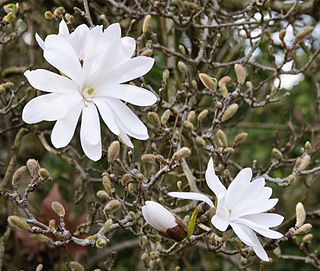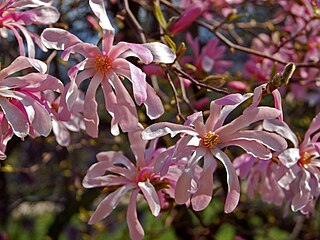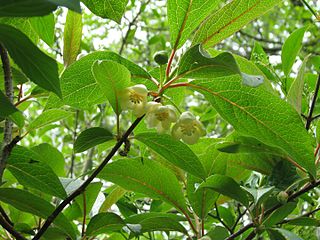
Magnolia is a large genus of about 210 flowering plant species in the subfamily Magnolioideae of the family Magnoliaceae. It is named after French botanist Pierre Magnol.

Magnolia virginiana, most commonly known as sweetbay magnolia, or merely sweetbay, is a member of the magnolia family, Magnoliaceae. It was the first magnolia to be scientifically described under modern rules of botanical nomenclature, and is the type species of the genus Magnolia; as Magnolia is also the type genus of all flowering plants (magnoliophytes), this species in a sense typifies all flowering plants.

Magnolia stellata, sometimes called the star magnolia, is a slow-growing shrub or small tree native to Japan. It bears large, showy white or pink flowers in early spring, before its leaves open. This species is closely related to the Kobushi magnolia, and is treated by many botanists as a variety or even a cultivar of that. However, Magnolia stellata was accepted as a distinct species in the 1998 monograph by Hunt.

Magnolia liliiflora is a small tree native to southwest China, but cultivated for centuries elsewhere in China and also Japan. Variously known by many names, including Mulan magnolia, purple magnolia, red magnolia, lily magnolia, tulip magnolia, Jane magnolia and woody-orchid, it was first introduced to English-speaking countries from cultivated Japanese origins, and is thus also sometimes called Japanese magnolia, though it is not native to Japan. It is now also planted as an ornamental in North America and Europe, though rather less often than its popular hybrid.

Magnolia denudata, the lilytree or Yulan magnolia, is native to central and eastern China. It has been cultivated in Chinese Buddhist temple gardens since 600 AD. Its flowers were regarded as a symbol of purity in the Tang Dynasty and it was planted in the grounds of the Emperor's palace. It is the official city flower of Shanghai.

Weigela is a genus of between six and 38 species of deciduous shrubs in the family Caprifoliaceae, growing to 1–5 m (3–15′) tall. All are natives of eastern Asia. The genus is named after the German scientist Christian Ehrenfried Weigel.
The International Code of Nomenclature for Cultivated Plants (ICNCP), also known as the Cultivated Plant Code, is a guide to the rules and regulations for naming cultigens, plants whose origin or selection is primarily due to intentional human activity. Cultigens under the purview of the ICNCP include cultivars, Groups, and grexes. All organisms traditionally considered to be plants are included. Taxa that receive a name under the ICNCP will also be included within taxa named under the International Code of Nomenclature for algae, fungi, and plants, for example, a cultivar is a member of a species.

Magnolia champaca, known in English as champak, is a large evergreen tree in the family Magnoliaceae. It was previously classified as Michelia champaca. It is known for its fragrant flowers, and its timber used in woodworking.

Symphyotrichum ericoides, known as white heath aster, frost aster, or heath aster, is a species of flowering plant in the family Asteraceae native to much of central and eastern North America. It has been introduced to parts of Europe and western Asia.

Symphyotrichum novi-belgii, commonly called New York aster, is a species of flowering plant. It is the type species for Symphyotrichum, a genus in the family Asteraceae, whose species were once considered to be part of the genus Aster. Plants in both these genera are popularly known as Michaelmas daisy because they bloom around September 29, St. Michael’s Day.

Symphyotrichum lateriflorum is a species of flowering plant of the family Asteraceae native to eastern and central North America. Commonly known as calico aster, starved aster, and white woodland aster, it is a perennial, herbaceous plant that may reach 120 centimeters high and 30 centimeters across. Each flower head has many tiny florets put together into what appear as one.

Symphyotrichum pilosum, commonly called hairy white oldfield aster or frost aster, is a flowering plant in the family Asteraceae native to central and eastern North America. It is a perennial, herbaceous plant that may reach 20 to 120 centimeters tall. Its flowers have white ray florets and yellow disk florets.

Magnolia × loebneriKache is a hybrid of two Magnolia species, the Japanese Magnolia kobus and M. stellata. crossed by Garteninspektor Max Löbner of Pillnitz, Germany, shortly before World War I; it first flowered in 1917. The deciduous, elegant and compact multi-stemmed small flowering tree or large shrub, slowly attaining a height of 20 ft (6.1 m) and somewhat wider at maturity, is hardy to USDA Zone 4. Its fragrant late flowers, following its stellata parent by a couple of weeks, escape unexpected late spring frosts, but appear on the bare branches, to great effect. The deep pink buds open in informal strap-like tepals with pale shell pink upper surfaces and darker pink-purple lower ones. Like most magnolias, it thrives best on acid soils.
James Edgar Dandy was a British botanist, Keeper of Botany at the British Museum between 1956 and 1966. He was a world specialist on the plant genus Potamogeton and the family Magnoliaceae.
Brian Frederick Mathew MBE, VMH is a British botanist, born in the village of Limpsfield, Surrey, England. His particular area of expertise is bulbous plants, particularly ornamental bulbous plants, although he has contributed to other fields of taxonomy and horticulture. He has authored or co-authored many books on bulbs and bulbous genera which appeal to both botanists and gardeners, as well as specialist monographs on other genera, including Daphne, Lewisia, and Helleborus. His work has been recognized by the British Royal Horticultural Society and the International Bulb Society.
Sir Frederick Claude Stern was a botanist and horticulturalist, known for developing the gardens at Highdown, for creating several cultivars of garden plants and for his publications on peonies, snowdrops and gardening. He also tried to promote the interests of the Jewish community.

William A. McNamara is an American horticulturist and expert in the field of plant conservation and the flora of Asia. Now retired, he was the President and Executive Director of Quarryhill Botanical Garden, a 25-acre wild woodland garden in Northern California's Sonoma Valley featuring wild-sourced plants from temperate East Asia. In 2017, he and Quarryhill Botanical Garden celebrated their 30th Anniversary. He retired from the Garden in October of 2019.

Eriocapitella × hybrida is a hybrid of flowering plants in the buttercup family Ranunculaceae. The parents of the hybrid are E. japonica and E. vitifolia. Cultivars of the hybrid are commonly known as Japanese anemone hybrids.

Schisandra grandiflora, called the large-flowered magnolia vine, is a species of flowering plant in the genus Schisandra, native to the Himalayas and Tibet. A deciduous, twining climber, it has gained the Royal Horticultural Society's Award of Garden Merit as an ornamental.

Symphyotrichum turbinellum, commonly called prairie aster in the United States and mauve-flowered starwort in the United Kingdom, is a species of flowering plant in the family Asteraceae native to the United States in Nebraska, Iowa, Illinois, Kansas, Missouri, Oklahoma, Arkansas, and Louisiana, primarily in the Ozarks. It has gained the Royal Horticultural Society's Award of Garden Merit.
















